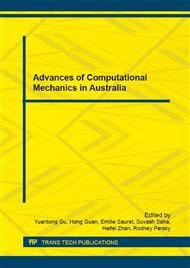[1]
McNamara, J. J. and Friedmann, P. P., Aeroelastic and Aerothermoleastic Analysis of Hypersonic Vehicles: Current States and Future Trends, AIAA Journal, (2007).
Google Scholar
[2]
Fidan, B., Mirmirani, M. and Ioannou, P. A., Flight Dynamics and Control of Air Breathing Hypersonic Vehicles: Review and New Directions, 12th AIAA International Space Planes and Hypersonic Systems and Technologies, AIAA paper 2003-7081, (2003).
DOI: 10.2514/6.2003-7081
Google Scholar
[6]
Livine, E., Aeroelasticity of Nonconventional Airplane Configurations – Past and Future, Journal of Aircraft, Vol. 40, 2003, pp.1047-1065.
DOI: 10.2514/1.2273
Google Scholar
[7]
Gnoffo, P. A., Weilmuenster, K. J., Hamilton, H. H., Olynick, D. R. and Venkatapathy, E., Computational Aerothermodynamic Design Issues for Hypersonic Vehicles, Journal of Spacecraft and Rockets, Vol. 36, 1999, pp.21-43.
DOI: 10.2514/2.3430
Google Scholar
[8]
Lamorte, N. and Friedmann, P. P., Hypersonic Aeroelastic and Aerothermoelastic Studies using Computational Fluid Dynamics, AIAA Journal, Vol. 52, 2014, p.2062-(2078).
DOI: 10.2514/1.j053018
Google Scholar
[9]
Dugundji, J. and Calligeros, J. M., Similarity Laws for Aerothermoelastic Testing, Journal of the Aerospace Sciences, Vol. 29, 1962, pp.935-950.
DOI: 10.2514/8.9663
Google Scholar
[10]
Reaction Engines, LAPCAT A2, 2012. [Online]. Avaliable: http: /www. reactionengines. co. uk/lapcat. html. [Accessed 12 September 2015].
Google Scholar
[13]
Verstraete, D., Sharifzadeh, S. and Hendrick P., Definition and Aero-Elastic Optimisation of the Structure of the LAPCAT A2 Mach 6 Airliner, Brisbane, Australia, (2012).
DOI: 10.2514/6.2012-5942
Google Scholar
[14]
Friedmann, P. P., McNamara, J. J., Thuruthimattam, B. J. and Powell, K. G., Hypersonic Aerothermoelasticity with Application to Reusable Launch Vehicles, 12th AIAA International Space Planes and Hypersonic Systems and Technologies, AIAA paper 2003-7014, (2003).
DOI: 10.2514/6.2003-7014
Google Scholar
[15]
McClinton, C. R., X-43-Scramjet Power Breaks the Hypersonic Barrier, Reno, Nevada, (2006).
Google Scholar
[16]
Cavagna, L., Gaspari, A. D., Ricci, S., Riccobene, L. and Travaglini, L., NEOCASS: An Open Source Environment for the Aeroelastic Analysis at Conceptual Design Level, 28th International Congress of the Aeronautical Sciences, Brisbane, Australia, (2012).
DOI: 10.2514/6.2010-8241
Google Scholar
[17]
Bowcutt, K. G. and Hatakeyama S. J., Challenges, Enabling Technologies and Technology Maturity for Respective Space., AIAA 2nd Responsive Space Conference, AIAA paper 2004-6005, (2004).
Google Scholar
[18]
Cavagna, L., Structural Sizing, Aeroelastic Analysis, and Optimization in Aircraft Conceptual Design, Journal of Aircraft, Vol. 48, 2011, pp.1840-1855.
DOI: 10.2514/1.c031072
Google Scholar
[19]
Reynolds, K. W., Aero-Propulsive-Elastic-Modeling in OpenVSP, Intelligent Systems Division, NASA Ames Research Center, (2013).
Google Scholar
[20]
Morrell, B. J., Munk, D. J., Vio, G. A. and Verstratete D., Development of a Hypersonic Aircraft Design Optimisation Tool, Applied Mechanics and Materials, Vol. 553, 2014, pp.847-852.
DOI: 10.4028/www.scientific.net/amm.553.847
Google Scholar
[21]
Snapp, D. K. and Pomeroy R. C., A Geometry System for Aerodynamic Design, St. Louis Missouri, (1987).
Google Scholar
[22]
Johnson F. T., TranAir: a Full-Potential, Solution Adaptive, Rectangular Grid Code for Predicting Subsonic, Transonic and Supersonic Flow about Arbitrary Configurations: User's Manual, Boeing Military Airplane Company, Seattle, Washington, (1992).
Google Scholar
[23]
Anderson, J. D., Hypersonic and High-Temperature Gas Dynamics, 2nd ed., Reston, Virginia: American Institute of Aeronautics and Astronautics, (2006).
Google Scholar
[24]
Collier, C., Yarrington, P., Pickenheim, M. and Bednarcyk, B., An Approach to Preliminary Design and Analysis, 48th AIAA/ASME/ASCE/AHS/ASC Structures, Structural Dynamics and Materials Conference, Honolulu, Hawaii, AIAA paper 2007-2176, (2007).
DOI: 10.2514/6.2007-2176
Google Scholar
[25]
Varvill, R. and Bond, N., LAPCAT II A2 Vehicle Structure Design Specifications, Long-Term Advanced Propulsion Concepts and Technologies II, (2008).
Google Scholar


